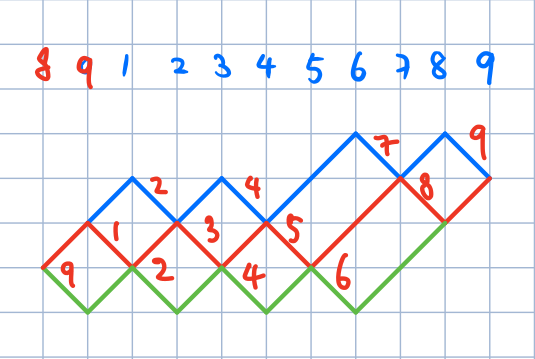Rigid indecomposable modules in the category ${\rm CM}(A)$ of Cohen-Macaulay $A$-module are parametrized by certain arrays of integers called profiles as shown in the paper A categorification of Grassmannian cluster algebras. For example, $P_1' = \begin{array}{cccc} 2 & 4 & 7 & 9 \\ \hline 1 & 3 & 5 & 8 \\ \hline 2 & 4 & 6 & 9 \end{array}$ is a profile. We have that $\tau(1357)=\begin{array}{cccc} 2 & 4 & 7 & 9 \\ \hline 1 & 3 & 5 & 8 \\ \hline 2 & 4 & 6 & 9 \end{array}$, where $\tau$ is the Auslander-Reiten translation.
We translate the array of integers $P_1'$ into another array of integers as follows. We draw the picture of $P_1'$ as follows (in the ith path of the picture, the down steps are the numbers in the ith row of $P_1'$, cf. Figure 9 of A categorification of Grassmannian cluster algebras).
I draw the picture in a way such that the pictures is formed by closed boxes. Now we define a new array of integers $P_1$ by requiring the ith column of $P_1$ is the numbers appearing in the $(k-i)$th (in the above example, $k=4, n=9$) path of the picture of $P_1'$. Then $P_1 = \left( \begin{matrix} 9 & 1 & 2 \\ 2 & 3 & 4 \\ 4 & 5 & 7 \\ 6 & 8 & 9 \end{matrix} \right)$.
On the other hand, Marsh and Scott defined a twist map on Grassmannian in the paper. The twist of the Plucker coordinate $P_{1,3,5,7}$ gives a tableau $T_1 = \left(\begin{array}{ccc} 1 & 2 & 4\\ 2 & 3 & 7\\ 4 & 5 & 8\\ 6 & 9 & 9 \end{array}\right)$. The twist map corresponds to Auslander-Reiten translation. Therefore $P_1$ and $P_1'$ should correspond to $T_1$.
The shift of a profile by $1$ (adding $1$ to each number mod $n$) will correspond to the promotion of the corresponding tableau.
Let $P_1, \ldots, P_9$ be the following arrays of integers: \begin{align*} \left( \begin{matrix} 9 & 1 & 2 \\ 2 & 3 & 4 \\ 4 & 5 & 7 \\ 6 & 8 & 9 \end{matrix} \right), \left( \begin{matrix} 1 & 2 & 3 \\ 3 & 4 & 5 \\ 5 & 6 & 8 \\ 7 & 9 & 1 \end{matrix} \right), \left( \begin{matrix} 2 & 3 & 4 \\ 4 & 5 & 6 \\ 6 & 7 & 9 \\ 8 & 1 & 2 \end{matrix} \right), \left( \begin{matrix} 3 & 4 & 5 \\ 5 & 6 & 7 \\ 7 & 8 & 1 \\ 9 & 2 & 3 \end{matrix} \right), \left( \begin{matrix} 4 & 5 & 6 \\ 6 & 7 & 8 \\ 8 & 9 & 2 \\ 1 & 3 & 4 \end{matrix} \right), \left( \begin{matrix} 5 & 6 & 7 \\ 7 & 8 & 9 \\ 9 & 1 & 3 \\ 2 & 4 & 5 \end{matrix} \right), \left( \begin{matrix} 6 & 7 & 8 \\ 8 & 9 & 1 \\ 1 & 2 & 4 \\ 3 & 5 & 6 \end{matrix} \right), \left( \begin{matrix} 7 & 8 & 9 \\ 9 & 1 & 2 \\ 2 & 3 & 5 \\ 4 & 6 & 7 \end{matrix} \right), \left( \begin{matrix} 8 & 9 & 1 \\ 1 & 2 & 3 \\ 3 & 4 & 6 \\ 5 & 7 & 8 \end{matrix} \right). \end{align*} $P_i$ is obtained from $P_{i-1}$ by adding $1$ (mod $9$) to every entry of $P_{i-1}$.
These arrays of integers correspond to the following semistandard Young tableaux $T_1, \ldots, T_9$ respectively (these tableaux can be obtained from each other by promotion): \begin{align*} & \left(\begin{array}{ccc} 1 & 2 & 4\\ 2 & 3 & 7\\ 4 & 5 & 8\\ 6 & 9 & 9 \end{array}\right),\left(\begin{array}{ccc} 1 & 1 & 3\\ 2 & 4 & 5\\ 3 & 6 & 8\\ 5 & 7 & 9 \end{array}\right),\left(\begin{array}{ccc} 1 & 2 & 4\\ 2 & 3 & 6\\ 4 & 5 & 7\\ 6 & 8 & 9 \end{array}\right),\left(\begin{array}{ccc} 1 & 3 & 5\\ 2 & 4 & 7\\ 3 & 6 & 8\\ 5 & 7 & 9 \end{array}\right),\left(\begin{array}{ccc} 1 & 2 & 4\\ 3 & 5 & 6\\ 4 & 7 & 8\\ 6 & 8 & 9 \end{array}\right), \\ & \left(\begin{array}{ccc} 1 & 3 & 5\\ 2 & 4 & 7\\ 5 & 6 & 8\\ 7 & 9 & 9 \end{array}\right),\left(\begin{array}{ccc} 1 & 1 & 4\\ 2 & 5 & 6\\ 3 & 7 & 8\\ 6 & 8 & 9 \end{array}\right),\left(\begin{array}{ccc} 1 & 2 & 5\\ 2 & 3 & 7\\ 4 & 6 & 8\\ 7 & 9 & 9 \end{array}\right),\left(\begin{array}{ccc} 1 & 1 & 3\\ 2 & 4 & 6\\ 3 & 7 & 8\\ 5 & 8 & 9 \end{array}\right). \end{align*}
I think that there is a combinatorial rule to obtain $T_i$ from $P_i$. We can move elements which are not in the correct position to a correct position. It seems that it is similar to Jeu de taquin. But I have not figured out that. Any help would be greatly appreciated. Thank you very much.

